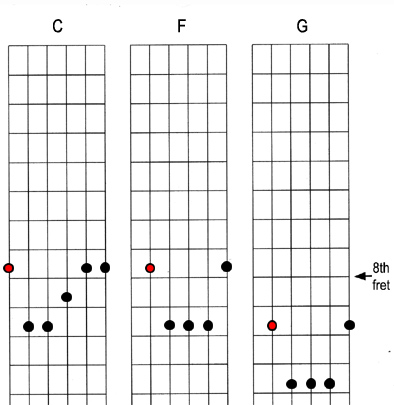Theory Made Easy 1
What is a Key?
A Key is basically a scale and a set of chords.
The first note ( root ) of the scale gives us the name of the Key.
So, for example, you might say I'm playing this tune in the Key of C.
You might then say this Key is too high ( or low ) for my voice so let's play
exactly the same tune but in a different Key.
As there are 12 different notes so there are 12 different names for keys.
What is a Key Structure ?
A Key structure is the combination of chords and melody within particular rules
defined by the scale.
In this first lesson I'm going to look at the Key Structure of C
Major
This is defined by the Scale of C Major.
[C D E F G A B C ] see tab example below.
A Key Structure is not quite the same thing as a Key in that , for example,
it is possible to play in the Key of A Minor using the Key Structure
of C Major.
What is a Three Chord Trick ?
Used disparagingly by ignorant journalists to describe bands or musicians who
only seem to know three chords - actually the three chord trick is the basis
of western music and a great way to understand theory.
The three chords are based on the first, fourth and fifth notes of the scale.
Usually written as roman numerals I - IV - V = 1 - 4 - 5
In the Key of C Major the 3 chords are:
C major - first - or root = I
F major - fourth = IV
G major - fifth = V
The diagrams below show these as barre chords with the root note of each in
red.

It is important to play them this way as once you have learnt
the key structure of C major you can then work out the structure of any other
key by moving up or down the neck.
If you analyze the individual notes found within these three chords you will
find you have a scale of C Major.
This means that any melody using notes from the scale of C Major can be harmonized
( put chords behind ) using only these three chords.
In mediaeval church music it was actually forbidden to use any other chords
! — A tradition that may have resurfaced in the early days of Punk!!
The Tab

Exercise
Using the above information work out the three chord trick for all the other
eleven keys. Note that the root note of the three chords goes from the 6th
string straight across to the 5th string and then up two frets.
© freeguitartuition.com
